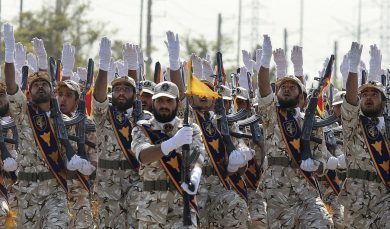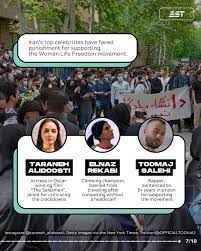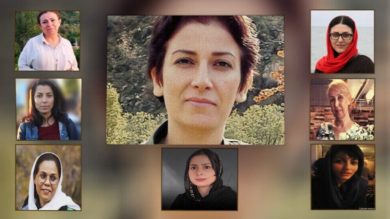In Iran, a country where wearing the hijab is legally enforced, removing it in public is not just a personal act—it is a powerful act of political protest. Over the past year, especially following the death of 22-year-old Mahsa Amini in the custody of Iran’s morality police in 2022, women across Iran have increasingly used the hijab as a symbol of resistance, defying decades of state-imposed dress codes.
The Islamic Revolutionary Guard Corps (IRGC) and morality police have long enforced the hijab through surveillance, arrests, and intimidation. But now, what was once a symbol of state control has become a flag of protest, waved silently but visibly on the streets of Tehran, Mashhad, Isfahan, and beyond.
This article explores the roots, risks, and power of hijab defiance in Iran’s modern protest movement.
1. The History of Compulsory Hijab in Iran
After the 1979 Islamic Revolution, the hijab quickly became a cornerstone of the Islamic Republic’s ideology. In 1983, the Iranian parliament passed a law making it mandatory for all women to wear the hijab in public. Those who failed to comply faced fines, lashes, or imprisonment.
Since then, the hijab has evolved from a religious or cultural garment into a symbol of state control over women’s bodies and autonomy. It is not merely about clothing—it is about identity, obedience, and politics.
2. Mahsa Amini: The Spark That Ignited a Movement
On September 16, 2022, Mahsa Amini died in the custody of the morality police after being arrested for “improper hijab.” Her death triggered a nationwide wave of protests, with thousands of women publicly removing their hijabs in protest.
The slogans chanted—“Women, Life, Freedom”—were echoed not only in Iran but in protests around the world. Mahsa became a martyr and the hijab became a battleground.
3. The Hijab as a Symbol of Resistance
For many Iranian women, removing the hijab in public is the ultimate act of defiance. It is a quiet but brave challenge to the state, carried out in everyday settings like streets, metro stations, and classrooms.
These acts say:
• “I am not afraid.”
• “I own my body.”
• “I reject forced obedience.”
Images of women walking unveiled in public—often filmed by bystanders or shared anonymously on social media—have become powerful protest statements, each one sparking new acts of courage.
4. The IRGC’s Reaction: Crackdowns and Surveillance
The IRGC and morality police have responded with brutal force. Women seen without hijabs are:
• Fined and arrested
• Monitored via surveillance cameras
• Dismissed from schools and workplaces
• Subjected to public shaming
Yet, these crackdowns have not stopped the movement—they’ve amplified it. Each attempt to silence women only draws more attention to their resistance.
5. From Private Rebellion to Public Movement
What began as a private decision—removing the hijab—has transformed into a public, political act. Women no longer hide their resistance. In some cases, entire groups of women walk unveiled together in solidarity, despite the risks.
Many are supported by their male allies, LGBTQ+ activists, and other marginalized communities, turning hijab defiance into a unified national movement for rights and dignity.
6. Social Media: The Global Amplifier
Social media has played a crucial role in turning local acts of defiance into global symbols of resistance. Campaigns like #LetUsTalk, #MyStealthyFreedom, and #No2Hijab have:
• Shared the stories of brave Iranian women
• Challenged the regime’s narrative internationally
• Garnered support from global feminists and human rights groups
Platforms like Instagram and Twitter, despite internet censorship, remain lifelines of visibility and solidarity.
7. Hijab Defiance and Broader Feminist Demands
Iranian women’s protest is not just about hijab—it’s about bodily autonomy, freedom of choice, equal rights, and political transformation. Women are now demanding:
• End to gender apartheid
• Legal reform on family and labor rights
• Accountability for state violence
• Inclusion in political decision-making
The hijab protest has become a gateway to deeper feminist revolution.
8. Risks and Sacrifices
Many women who defy the hijab law face severe consequences:
• Imprisonment and torture (e.g., Sepideh Rashno, Narges Mohammadi)
• Loss of jobs, education opportunities, and public services
• Surveillance and psychological harassment
Yet, their defiance continues, proving that the fear barrier has broken.
9. Global Support and What It Means
International outcry following Mahsa Amini’s death pressured governments and human rights groups to act. This includes:
• Sanctions on IRGC officials
• United Nations statements of condemnation
• Nobel Peace Prize awarded to jailed activist Narges Mohammadi
Still, more action is needed—including asylum protection, digital freedom support, and persistent diplomatic pressure.
Conclusion: The Power of Unveiled Protest
In Iran, a woman taking off her hijab in public is not simply choosing what to wear—it’s a radical political act. The hijab, once used by the regime to control, is now used by women to resist.
Join Our Newsletter!
Stay informed with the latest updates, news, and ways to take action in the fight for justice and global security. Sign up now to get updates delivered straight to your inbox!




